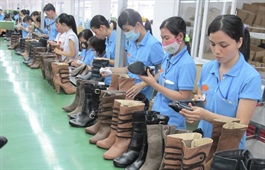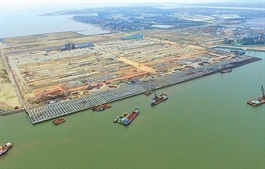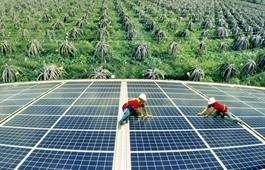Viet Nam’s PMI dips to 51.3 in January
Viet Nam’s PMI dips to 51.3 in January
The Vietnam Manufacturing Purchasing Managers' Index (PMI) was 51.3 in January, down from 51.7 in December, to signal a softer improvement in business conditions at the start of 2021.

According to the latest survey from Nikkei and IHS Markit revealed on Monday, although business conditions in the Vietnamese manufacturing sector improved at the start of 2021, growth was softer than at the end of 2020. Production, employment and purchasing activity were all broadly unchanged in January, while new orders increased at a slower rate.
Meanwhile, a lack of shipping containers and raw material shortages meant severe supply-chain disruption, which in turn contributed to the fastest rise in input costs since June 2018.
The survey showed new orders continued to rise, extending the current sequence of expansion to five months. There were some reports of customers increasing the size of their orders. That said, the rate of growth eased from December. Meanwhile, new export orders were broadly unchanged, with weakness noted in markets where coronavirus (COVID-19) case numbers remained elevated.
January saw a broadly stable picture for manufacturing production. While the rise in new orders supported increases in output at some firms, others reported that the effects of the COVID-19 pandemic continued to lead to falls in production.
The aforementioned increases in size of some orders started to impart pressure on capacity during January. Although backlogs of work decreased for the twelfth successive month, the rate of depletion was the softest in this sequence.
According to the survey, manufacturers kept their workforce numbers broadly unchanged, following a rise in December. Some firms raised employment in response to higher new orders, while others noted a reduction amid the pandemic and staff resignations. Purchasing activity was also little changed.
Efforts to secure inputs were stymied by severe disruption to supply chains again in January. In fact, the extent of the latest lengthening of delivery times was the greatest for almost a decade, except for during the worst of the COVID-19 lockdowns in March and April last year. Firms often reported a lack of shipping containers, as well as shortages of raw materials.
Issues with shipping and raw material supply added to inflationary pressures. The rate of input cost inflation quickened for the fifth month running and was the fastest since June 2018.
Output prices, meanwhile, increased for the fifth successive month, albeit at a modest pace that was much weaker than that seen for input costs.
Efforts to guard against raw material price rises led firms to increase their stocks of purchases, the second month running in which this has been the case.
On the other hand, stocks of finished goods decreased, and to the greatest extent in five months.
Although manufacturers remained confident regarding the 12-month outlook, sentiment dipped to a five-month low amid concerns about the ongoing effects of COVID-19. Where firms were optimistic, this reflected hopes for a reduced pandemic impact and plans for investment and production expansions.
“The Vietnamese manufacturing sector struggled to gain momentum at the start of 2021, as the ongoing effects of the COVID-19 pandemic and substantial disruption to supply chains hampered operations. The data suggest that while the Vietnamese economy remains one of the better performers globally, there are significant headwinds that could prevent a return to the stellar growth rates seen pre-pandemic in the near-term at least," Andrew Harker, Economics Director at IHS Markit, said.
IIP up over 22%
The General Statistics Office (GSO) reported Viet Nam’s index of industrial production (IIP) rose by 22.2 per cent year-on-year in January, demonstrating the sector’s strong growth.
Manufacturing recorded the largest gain at 27.2 per cent, followed by an increase of 16.3 per cent in power generation and distribution.
Water supply and waste treatment climbed 8.4 per cent while mining and quarrying declined by 6.2 per cent.
Major industrial products with strong growth in January included television sets, phone parts, rolled steel, raw iron and steel, automobiles, cement, textiles from natural fibre and powder milk.
Director of the GSO’s Industrial Statistics Department Pham Dinh Thuy suggested ministries, agencies and local governments should continue carrying out reform so that enterprises can have prompt and easy access to support policies.
It was necessary to assist the business community in looking for new markets for materials and spare parts, as well as encouraging people to prioritise buying local goods so as to help domestic firms overcome this difficult period, he added.

























